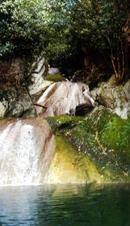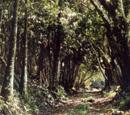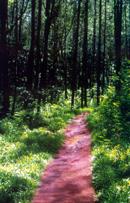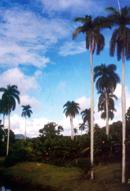Down the shortcut
As mistaken as it might appear, the prevailing image of Cuba that pops up in everyone's mind when you think of the island nation as a tourist destination is that of paradise-like beaches under the hot sweltering summer sun, crystal-clear waters and lavish hotels dotting the long shorelines. However, an increasing number of travelers are trekking to Cuba seduced by its natural charms.
Made up of over 4,000 islets and keys, the Cuban archipelago stands out for the beauty of its mountains, its breathtaking flora and wildlife that comprise some 8,000 plants, 900 fish species, roughly 300 birds, 4,000 mollusks and around 7,000 insects.
Other states' mistakes and experiences drive tourists to take a shortcut down to Cuba in an effort to expand this modality linked to nature tourism.
Today, we can say people are beginning to take on an environment-friendly attitude. Many point to sustainable development as the only way out to put a top-quality product in the hands of future generations –there are even laws and pieces of legislation that lay bare the Cuban government's commitment to environmental protection.
An assessment made nearly five years ago with the help of a number of tourist institutions, indicates that Cuba has approximately 4,000 accommodations clustered in natural areas. Indeed, only a quarter of that amount is readily available. Tourist authorities are working on more than a hundred trails, paths hikes and tours, all of them properly marked with information and no-can-do signs. Similar efforts are underway to soup up the training of those who will be charged with taking care of the environment. On the whole, this paints a clear-cut picture of Cuba as a destination ready to face up to market diversification.
Such regions as Viñales, Las Terrazas and Soroa in Pinar del Rio; the Zapata Peninsula in Matanzas; Guajimico in Cienfuegos; Topes de Collantes in Sancti Spiritus, and Sierra Maestra in Granma and Santiago de Cuba, cloister the largest chunk of national resources for the expansion of this particular segment in what must be construed as a clear sign of evolution.
Coincidentally, the markets leaning more to this kind of activity all around the globe are Canada, Germany, France, Spain and Italy, Cuba's top tourist-sending countries, that dispatch as many as 40 million sunbathers to outdoor spaces every year.
Another factor worth taking due account of is what experts call “the aging of sun-and-beach offers,” an aspect well traded on by nature travel that has little by little become an increasingly interesting product worldwide. Before the 9/11 terrorist attacks in the United States, nature tourism was growing an at annual average rate somewhere between 15 and 20 percent.
PINAR DEL RIO This is not a bad case of seeing all geese as swans, but Pinar del Rio is by far Cuba's Natural Cathedral. This perfect-looking landscape embraces roughly 11 percent of all endemic species. Some good cases in point are the rubber palm –a true living fossil- the big ceiba tree, the Cayman oak, the Sierra palmetto and scores of other trees, shrubs, bushes and plants of all kinds. When it comes to wildlife, however, endemic species are in the neighborhood of 50 percent, especially as far as bird species are concerned.
Since the 19th century, the natural beauty of the region that produces the world's finest tobacco lured the residents of Havana who traveled there to watch the Portales Caves, to heal their ailments and wounds in the soothing waters of San Diego de los Baños or to simply feast their eyes on the Viñales Valley.
VIÑALES First declared National Monument and later a Cultural Landscape of Mankind, the Viñales Valley ranks as the very best instance of the country's classical valleys and, perhaps, as the best-known Cuban landscape everywhere under the sun.
The valley features its round-top, vertical-hillside mountains known as mogotes whose inner caverns and rivulets make up one of the most important mountainous systems on the face of the earth.
The small town there seems to be stuck in the 19th century. Its urban layout keeps the ambience of yesteryear while the village is teeming with enchanted authenticity.
SOROA Lying some 45 miles west of Havana, Soroa is marked by great flora, an eye-catching assortment of shrubs, trees, wild orchids and ferns. The wildlife features the world's tiniest frog and some 70 bird species, some of them hailing exclusively from Cuba.
Soroa's orchid breeding grounds comprise as many as 750 species –a hundred of them only found on the island nation. Not far from there, the waterfalls of the Manantiales River beckons visitors to take a refreshing swim and watch the seven colors of the light spectrum caused by the reflection of sunlight at certain times of the day.
LAS TERRAZAS Within the Rosario Sierra, the first biosphere reserve internationally recognized in Cuba, Las Terrazas take up a natural area of 5,000 acres. The premises are the proud hosts of a sustainable rural economic project based on a rational tourist exploitation of the abundant natural wealth that make the surrounding community named after it and its peculiar architecture quite a standout.
The ruins of former 19th-century coffee plantations and farms are also destined to pack a wallop among travelers.
THE ZAPATA PENINSULA A narrow strip of land of 447,000 acres is what the Zapata Swamplands are all about, the largest chunk of them has been in the wise hands of Mother Nature, thanks in part to the inhospitable living conditions. Yet, the exclusive natural values found here are good enough to whet anybody's appetite for search and adventure.
Declared a Reserve of the Biosphere by UNESCO and an Internationally Important Wetland by the RAMSAR Convention, the region is penciled in as the richest and best- preserved marshland of the entire insular Caribbean.
Each day, thousands of people scour this moist landscape in search of history, beaches, coves, rivers, lagoons, lakes, flora and wildlife, elements all that cannot be seen elsewhere in the Cuban archipelago.
Diverse and endemic species here are simply fascinating for environmentalists and birdwatchers, as well as for those keen to hitting down paths and blazing their own trails.
By and large, the swamplands are inhabited by 160 bird species –some of them migratory- and 18 of the 22 endemic birds that nestle in Cuba. Three of those birds dwell only on these natural premises: the swamp finch (torrearnis inexpectata), the Caribbean whippersnapper (ferminia cerverai) and the St. Thomas bald coot (cyanolimnas cerverai).
The ground and marine wildlife cluster twelve mammal species, 31 reptiles (including the Cuban crocodile and the American alligator) and over a thousand insects (featuring more than a hundred spider species). But it takes more than sheer luck to page a couple of dwellers from the nearby rivers and lagoons, both endangered, that hail exclusively from this neck of the woods: the manatee (trichechus manatus) and an ancient fish known as manjuari (atractosteus tristoechus).
Vegetation embraces 900 different species, 110 botanical families, 18 formations and 5 endemic plants, a jaw-dropping assortment that makes it one of Cuba's premiere green areas.
The midland part of the territory –perched on somewhat higher grounds- features a forest brimming with large wood trees, while the rest of the marshes are covered by thickets of mangrove and swamp shrubs.
GUAJIMICO Halfway between the city of Cienfuegos and the colonial town of Trinidad, somewhere in the southern coast of Cuba, Villa Guajimico is across the board the main getaway for those who travel to this province pursuing the very best of nature.
Cienfuegos hosts Cuba's second-largest botanical garden and one of the most abundant ones in all of the Americas. It was founded in the early 20th century under the sponsorship of Harvard University in the United States.
The garden comprises 97 acres –seven of them embraced in a natural woodland- and showcases one of the world's most complete collections of palms and palmettos. In all, the garden has more than 2,000 plants –around 70 percent of them are exotic species- broken down in 670 genres and 125 families. Most of these trees are knotty, so a visit to the premises is equally interesting and attractive for researchers and lovers of general botany.
The Escambray mountain range juts out majestically to the northeast of the city, featuring steep peaks full of endemic plants and wildlife, springs, waterfalls, caves, ponds, natural watchtowers and in-between valleys, all of them packed with great adventures and conditions to practice mountain climbing. It'd be a shame to leave this place without paying a visit to such places as El Nicho, the Yaguanabo Valley, the Martin Infierno Cave (National Monument), and the San Juan Peak. If getting in touch with a rural environment is what your trip is all about, watching farmers milking cows, drinking a pot of fresh milk, tasting cheeses and tropical fruits, riding on horseback all the way to the mouth of the San Juan River, or taking a swim at an intimate cove by the shore, then you must head to the La Vega Estate.
TOPES DE COLLANTES Traditionally, Topes de Collantes, right in the heart of the Escambray mountain range, has been considered a top-of-the-line health and fitness destination. Health care facilities up there are excellent, but time has proved the area's biggest tourist potentials hinge on the environment itself.
This is no place for the sick, as some has mistakenly thought. First of all, you must be up and around to get there. Otherwise, there'll be no chance for you to know all the beauties the Topes de Collantes Nature Park has to offer.
Standing 800 meters above sea level, the region encloses sightseeing spots for adventure buffs and nature enthusiasts, for environmentalists and scientists, for trekkers and trailblazers. Its 23,000 acres of land –a safe haven for numerous flora and wildlife species- are divided into eight smaller parks whose main themes revolve around the natural attractions of the surroundings. There are barely 16 miles between this magnificent place and the colonial town of Trinidad, a city UNESCO declared Heritage of Mankind.
SIERRA MAESTRA Millions of years before the dawn of man, other beings and creatures inhabited the territory of the Granma province, where nature whipped landscapes into the natural masterpieces of today that make so many visitors go ooh and ah in amazement. The same reaction of pleasure is uttered by those who scout the Turquino and Desembarco del Granma nature parks, let alone the sea bottoms along the shoreline.
On the way to the top, the well-marked trails of the Sierra Maestra lead visitors to the island nation's three highest mountains: the Suecia Peak (1,734 meters above sea level) the Cuba Peak (1,872 m) and the Real del Turquino Peak (1,974 m). Its 17,450 acres of land provide shelter to an astonishing number of endemic plants, countless bird species –some of them exclusively found in the region- plus lots of reptiles, ground mollusks and mammals.
Mean temperature up in the Sierra Maestra mountain range goes from 16 to 20 degrees Celsius, relative humidity is pretty high all year round and rainfall is plentiful in the summer, a time of year when the watercourse of rivers usually swell and stream down the mountains. The many waterfalls and natural ponds invite visitors to take a swim.
During a tour around the mountains, hikers can take a firsthand look at the way uphill peasants live and enjoy themselves with music and singing, the way they eat and the many tropical fruits they grow up there. There are scores of historic places related to the last liberation war that came to triumphant close on January 1, 1959 with the beginning of the Revolution. One of those historic must-sees is La Plata, where the command center of the Rebel Army was stationed.
DESEMBARCO DEL GRANMA NATURE PARK At the base of the mountain, the cluster of the world's best preserved and outlined marine terraces comprises great flora and fauna, as many as 40 archeological sites dealing with the aboriginal people's culture and other spots linked to the independence wars waged during the second half of the 19th century and the mid-1950s liberation struggle. There are over 45 miles of caves and caverns, good enough for UNESCO to give the Desembarco del Granma Nature Park the title of Heritage of Mankind.
There are no words to express how many things travelers can find in the many archeological sites and trails, the countless natural and historic paths designed by the Flora and Wildlife Department attached to the Ministry of Agriculture in this province, taking into consideration the ruggedness of the terrain in each and every place.
Specialized guides explain to visitors –in a number of languages- the evolution of the soils in Cuba's southeastern region from the last 30 million years all the way to date, as well as the features of the unexplored semi-residual woods.
The expertise and skillfulness of the trailblazing guides are put through their paces on the way up and down the mountains –sometimes higher than 100 meters- and the hike into the different cavern systems. There are chances galore to gaze at the surrounding vegetation and one-and-only landscapes.
The routes also show a lighthouse and a mansion, both built in 1871 and sought after by corsairs and pirates in the past. There's a 77-meter-deep and 55-meter-wide fosse, pictographs, numerous challenges for mountain climbers, such oddities as the world's smallest orchid, the country's tallest cactus (as a matter of fact, it's four centuries old), the leaf gecko (a living fossil), endemic and migratory bird species, and a unique flora. In a word, Cuba is a huge botanical garden teeming with adventures and enjoyment for nature lovers. The island nation represents a valuable universe of exploration and scientific research in many branches of the natural sciences.








































































